Skin Delivery and in Vitro Biological Evaluation of Trans-Resveratrol-Loaded Solid Lipid Nanoparticles for Skin Disorder Therapies
Abstract
:1. Introduction
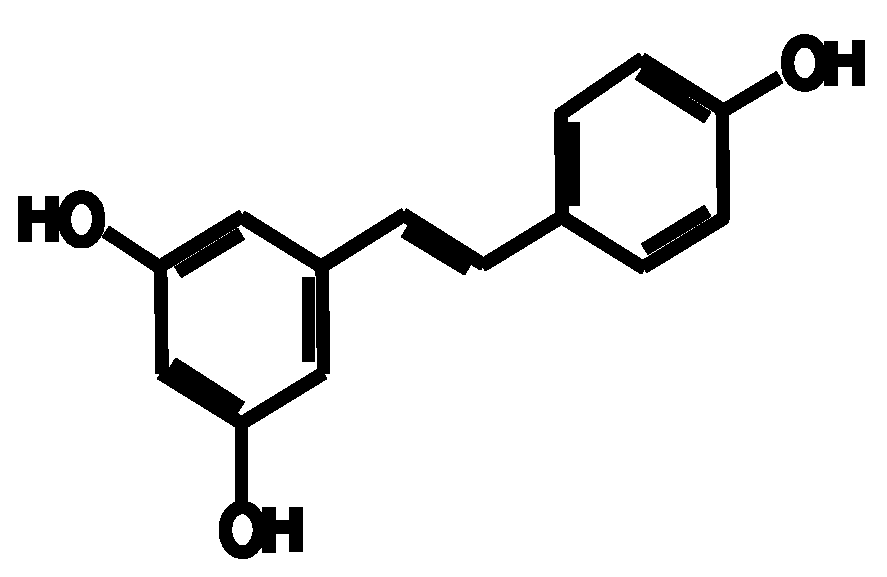
2. Results
2.1. Development of SLN
| Concentration of Raw Material (%) | ||
|---|---|---|
| F1 | F2 | |
| Stearic Acid (SA) | 5.00 | 5.00 |
| Poloxamer 407 (P407) | 3.50 | 3.50 |
| Soy Lecithin (SL) | - | 1.20 |
| Methylparaben | 0.18 | 0.18 |
| Propylparaben | 0.02 | 0.02 |
| Distilled water | q.s * | q.s * |
2.2. Hydrodynamic Size of Particles and Zeta Potential Analysis
| Z-Ave (d.nm) | PdI | ZP (mV) | |
|---|---|---|---|
| F1 | 194.9 ± 1.93 a | 0.230 ± 0.01 | −1.54 ± 0.31 |
| F2 | 137.67 ± 1.25 b | 0.157 ± 0.02 | −2.22 ± 1.12 |
| F1.RES | 155.50 ± 0.26 c | 0.140 ± 0.02 | −2.60 ± 1.27 |
| F2.RES | 166.23 ± 0.94 d | 0.196 ± 0.02 | −2.66 ± 0.33 |
2.3. SLN Morphology
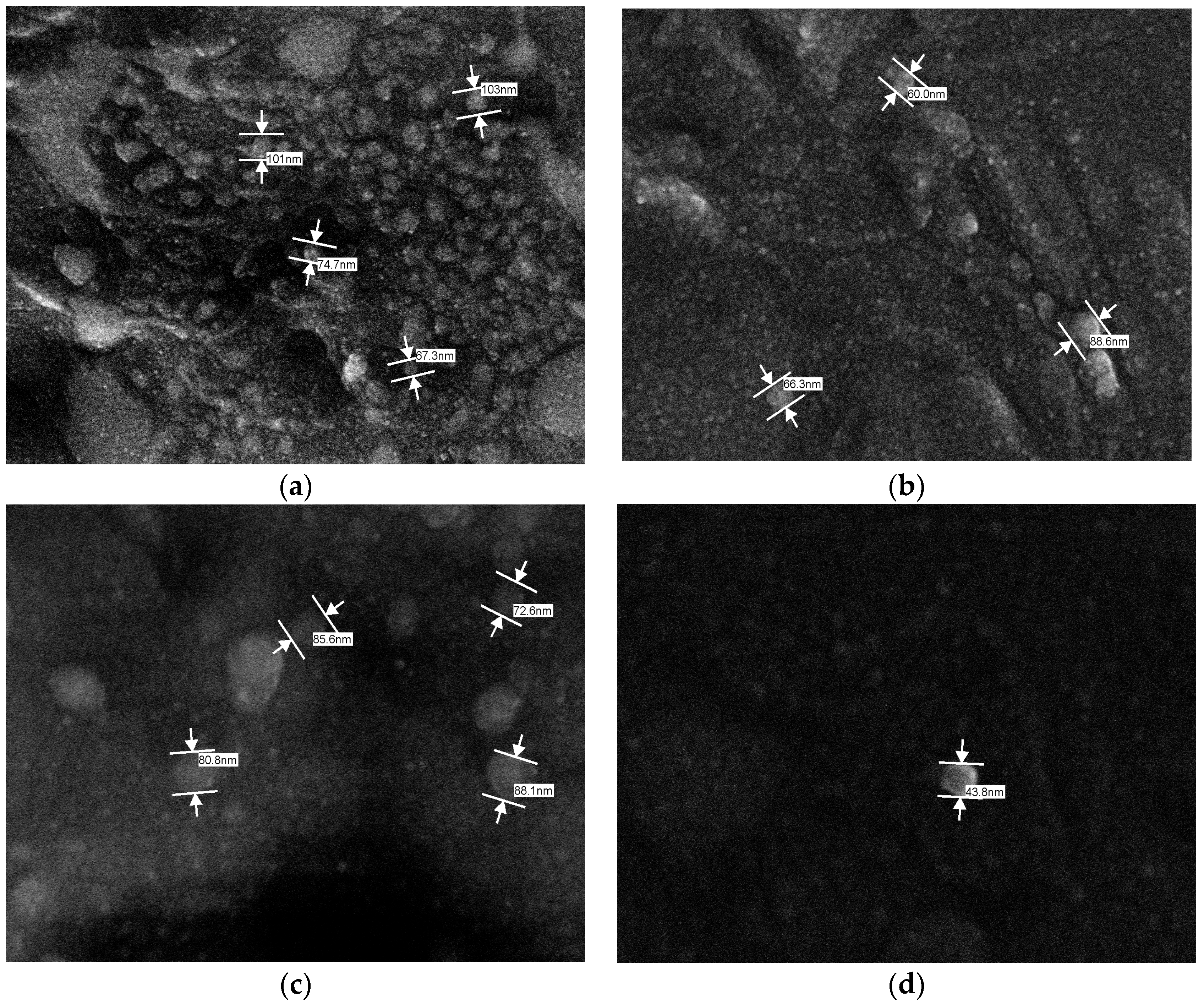
2.4. Characterization by Differential Scanning Calorimetry (DSC)
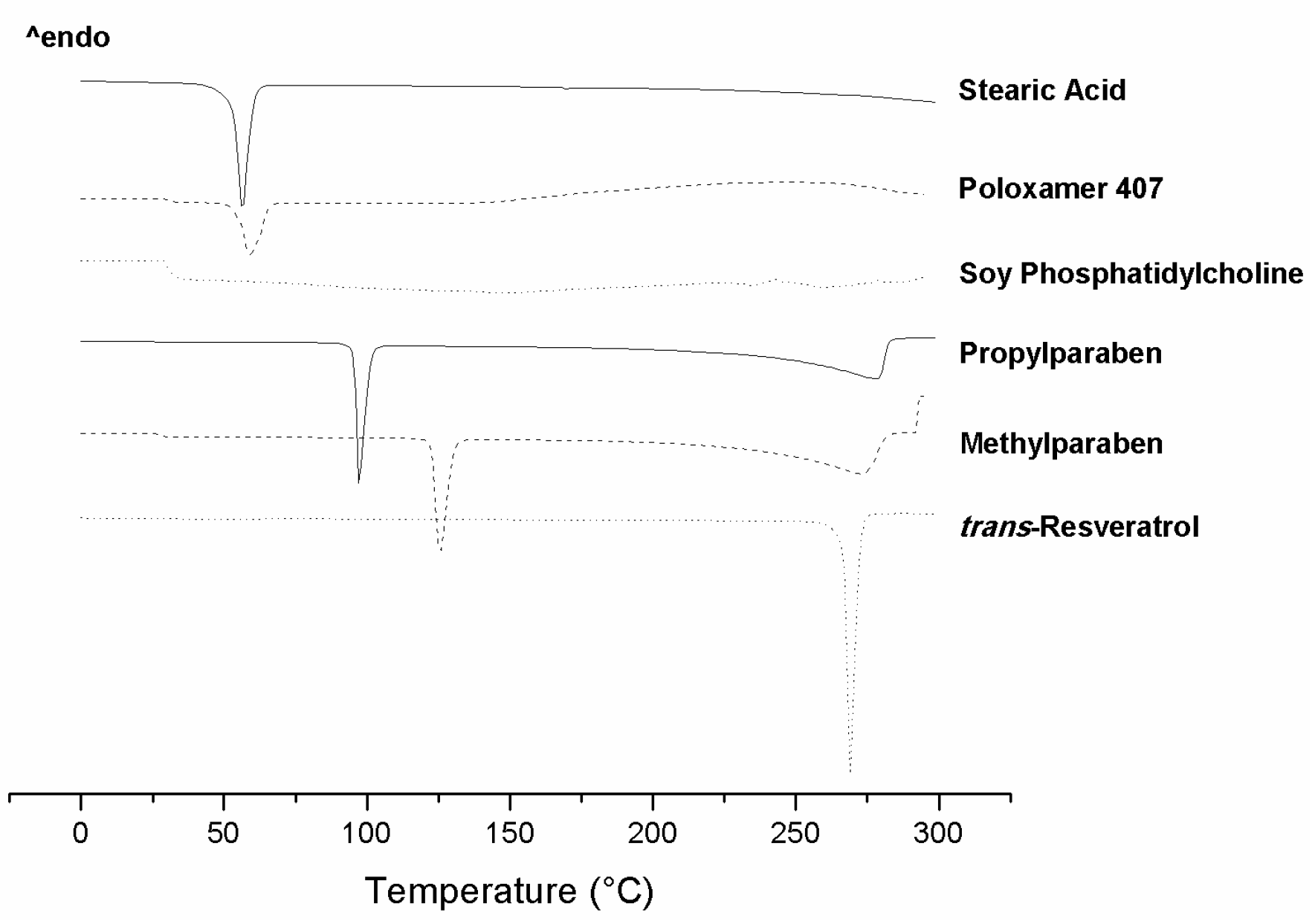
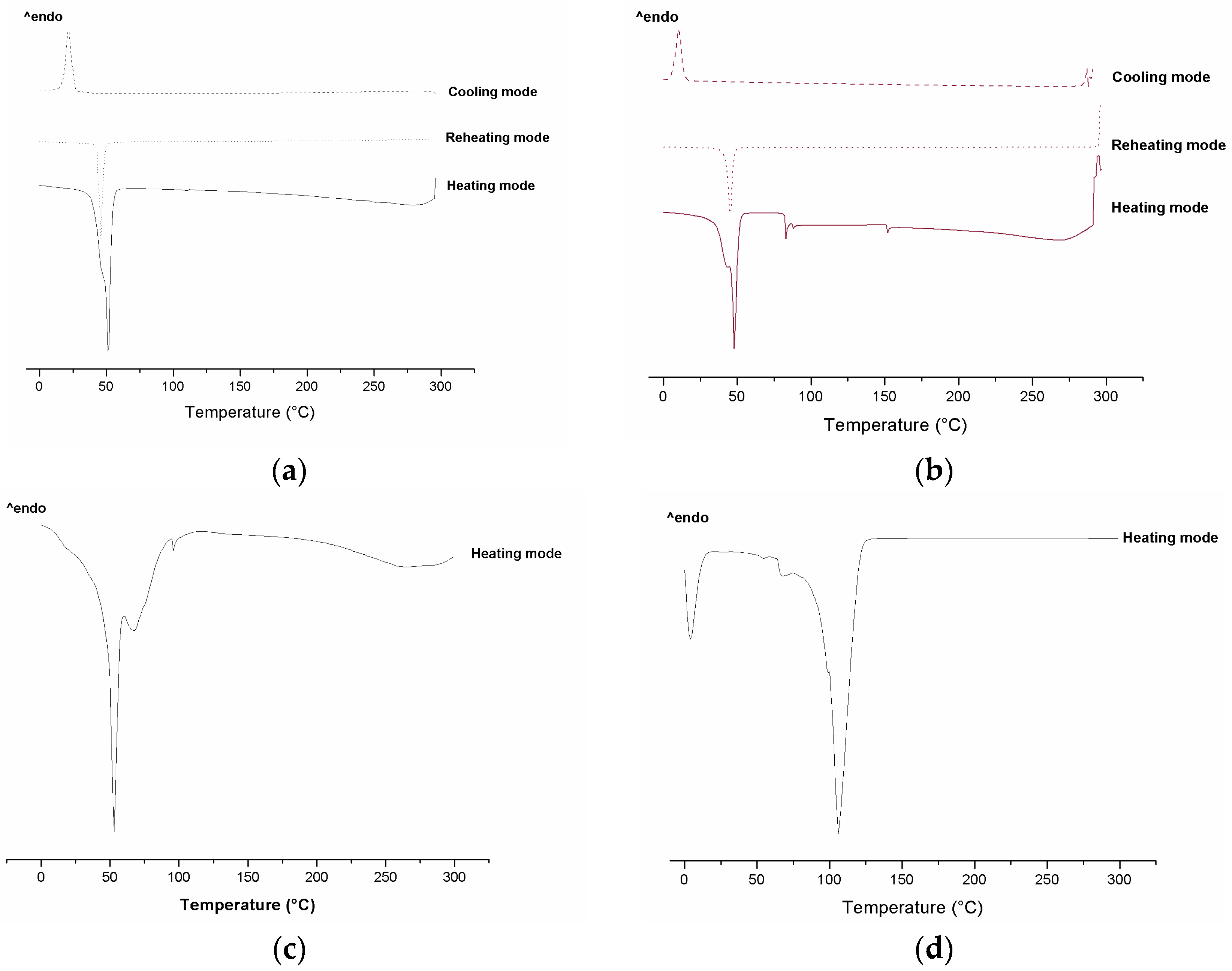
2.5. In Vitro Skin Permeation of RES
| Sample Name | Cumulative Amount (%) after 24 h |
|---|---|
| F1.RES | 45.26 ± 34.88 a |
| F2.RES | 18.61 ± 16.99 b |
2.6. In Vitro Tyrosinase Inhibition by RES-Loaded SLN
| Percentage of Inhibitory Activity (IA%) | |||||
|---|---|---|---|---|---|
| 5 μg·mL−1 | 10 μg·mL−1 | Equation | R2 | IA50 | |
| Kojic Acid | 25.06 | 57.82 | y = 6.1282x − 3.102 | 0.9595 | 8.66 |
| RES solution | 47.04 | 63.45 | y = 0.2314x + 58.208 | 0.4001 | nd * |
| F1.RES | 65.49 | 89.78 | y = 0.9413x + 85.111 | 0.6163 | nd * |
| F2.RES | 55.27 | 58.93 | y = 0.7520x + 57.034 | 0.8114 | nd * |
2.7. In Vitro MTT Cytotoxicity Assay of SLN
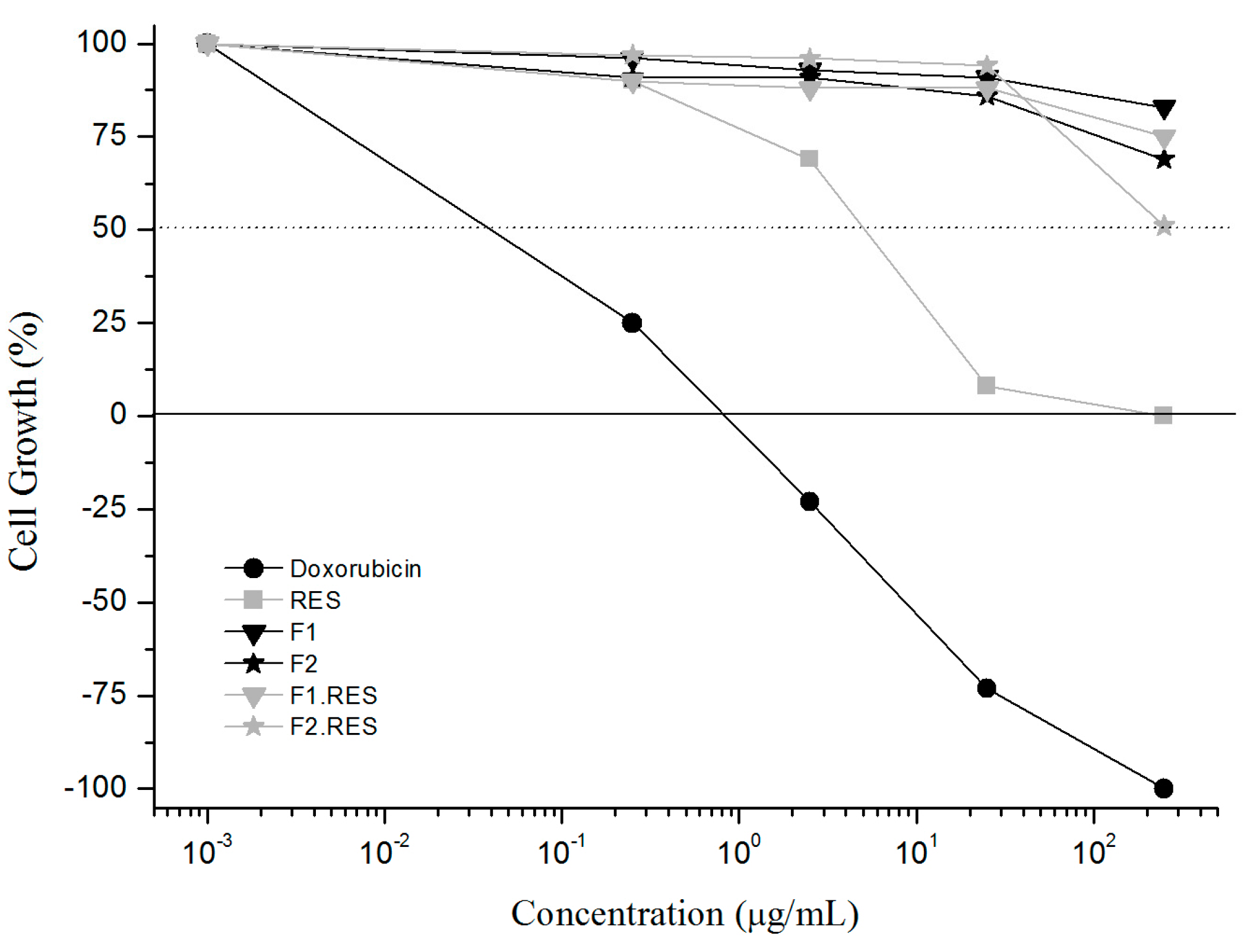
3. Discussion
4. Materials and Methods
4.1. Materials
4.2. Methods
4.2.1. Development of SLN
4.2.2. Hydrodynamic Size of Particle and Zeta Potential Analysis
4.2.3. SLNs Morphology
4.2.4. Characterization by Differential Scanning Calorimetry (DSC)
4.2.5. High-Performance Liquid Chromatographic (HPLC) Analysis of RES
4.2.6. In Vitro Skin Permeation of RES
4.2.7. In Vitro Tyrosinase Inhibition by RES-Loaded SLNs
4.2.8. In Vitro SLN Cytotoxicity Assay Using 3-(4,5-Dimethylthiazol-2-yl)-2,5-diphenyltetrazolium Bromide (MTT) in HaCat Keratinocytes
4.2.9. Statistical Analysis
5. Conclusions
Acknowledgments
Author Contributions
Conflicts of Interest
Abbreviations
| RES | trans-resveratrol |
| SLN | solid lipid nanoparticle |
| SA | stearic acid |
| SPC | soy phosphatidylserine |
| DLS | dynamic light scattering |
| SEM-FEG | scanning electron microscopy with field emission gun |
| DSC | differential scanning calorimetry |
| HPLC-PAD | high-performance liquid chromatographic with photodiode array |
| SC | stratum corneum |
| Z-Ave | mean hydrodynamic size |
| PdI | polydispersity index |
| TEWL | transdermal water loss |
| IA50 | 50% inhibitory activity |
| DOX | doxorubicin |
| DMEM | Dulbecco’s Modified Eagle's Medium |
| FBS | fetal bovine serum |
| MTT | 3-(4,5-dimethylthiazol-2-yl)-2,5-diphenyl tetrazolium bromide |
| ANOVA | analysis of variance |
References
- Ndiaye, M.; Philippe, C.; Mukhtar, H.; Ahmad, N. The grape antioxidant resveratrol for skin disorders: Promise, prospects, and challenges. Arch. Biochem. Biophys. 2011, 508, 164–170. [Google Scholar] [CrossRef] [PubMed]
- Fagundo, E.; Rodríguez-García, C.; Rodríguez, C.; González, S.; Sánchez, R.; Jiménez, A. Analysis of phenotypic characteristics and exposure to UV radiation in a group of patients with cutaneous melanoma. Actas Dermo Sifiliogr. 2011, 102, 599–604. [Google Scholar] [CrossRef] [PubMed]
- Bay, C.; Kejs, A.M.T.; Storm, H.H.; Engholm, G. Incidence and survival in patients with cutaneous melanoma by morphology, anatomical site and TNM stage: A danish population-based register study 1989–2011. Cancer Epidemiol. 2014, 39, 1–7. [Google Scholar] [CrossRef] [PubMed]
- Rigon, R.B.; Oyafuso, M.H.; Fujimura, A.T.; Gonçalez, M.L.; do Prado, A.H.; Gremião, M.P.D.; Chorilli, M. Nanotechnology-Based Drug Delivery Systems for Melanoma Antitumoral Therapy: A Review. Biomed. Res. Int. 2015, 2015, 1–22. [Google Scholar] [CrossRef] [PubMed]
- De Souza, G.A.; Godoy, L.M.; Teixeira, V.R.; Otake, A.H.; Sabino, A.; Rosa, J.C.; Dinarte, A.R.; Pinheiro, D.G.; Silva, W.A.; Eberlin, M.N. Proteomic and SAGE profiling of murine melanoma progression indicates the reduction of proteins responsible for ROS degradation. Proteomics 2006, 6, 1460–1470. [Google Scholar] [CrossRef] [PubMed]
- Slominski, A.; Paus, R.; Mihm, M. Inhibition of melanogenesis as an adjuvant strategy in the treatment of melanotic melanomas: Selective review and hypothesis. Anticancer Res. 1997, 18, 3709–3715. [Google Scholar]
- Slominski, A.; Wortsman, J.; Carlson, A.J.; Matsuoka, L.Y.; Balch, C.M.; Mihm, M.C. Malignant melanoma. Arch. Pathol. Lab. Med. 2001, 125, 1295–1306. [Google Scholar] [PubMed]
- Slominski, A.; Zbytek, B.; Slominski, R. Inhibitors of melanogenesis increase toxicity of cyclophosphamide and lymphocytes against melanoma cells. Int. J. Cancer 2009, 124, 1470–1477. [Google Scholar] [CrossRef] [PubMed]
- Sohn, N.; Gumport, S.L.; Gang, H.; Goldstein, M.; Deppisch, L.M. Generalized melanosis secondary to malignant melanoma. Report of a case with serum and tissue tyrosinase studies. Cancer 1969, 24, 897–903. [Google Scholar] [CrossRef]
- Gehm, B.D.; McAndrews, J.M.; Chien, P.Y.; Jameson, J.L. Resveratrol, a polyphenolic compound found in grapes and wine, is an agonist for the estrogen receptor. Proc. Natl. Acad. Sci. USA 1997, 94, 14138–14143. [Google Scholar] [CrossRef] [PubMed]
- Shukla, Y.; Singh, R. Resveratrol and cellular mechanisms of cancer prevention. Ann. N. Y. Acad. Sci. 2011, 1215, 1–8. [Google Scholar] [CrossRef] [PubMed]
- Kim, A.; Yang, Y.; Lee, M.S.; Yoo, Y.D.; Lee, H.G.; Lim, J.S. NDRG2 gene expression in B16F10 melanoma cells restrains melanogenesis via inhibition of Mitf expression. Pigment Cell Melanoma Res. 2008, 21, 653–664. [Google Scholar] [CrossRef] [PubMed]
- Santos, F.K.; Oyafuso, M.H.; Kiill, C.P.; Gremião, M.P.D.; Chorilli, M. Nanotechnology-based drug delivery systems for treatment of hyperproliferative skin diseases—A review. Curr. Nanosci. 2013, 9, 159–167. [Google Scholar]
- Souza, A.L.R.; Kiill, C.P.; Santos, F.K.; Luz, G.M.; Chorilli, M.; Gremião, M.P.D. Nanotechnology-based drug delivery systems for dermatomycosis treatment. Curr. Nanosci. 2012, 8, 512–519. [Google Scholar] [CrossRef]
- Liu, J.; Hu, W.; Chen, H.; Ni, Q.; Xu, H.; Yang, X. Isotretinoin-loaded solid lipid nanoparticles with skin targeting for topical delivery. Int. J. Pharm. 2007, 328, 191–195. [Google Scholar] [CrossRef] [PubMed]
- Wong, H.L.; Bendayan, R.; Rauth, A.M.; Li, Y.; Wu, X.Y. Chemotherapy with anticancer drugs encapsulated in solid lipid nanoparticles. Adv. Drug Deliver. Rev. 2007, 59, 491–504. [Google Scholar] [CrossRef] [PubMed]
- Noguchi, Y.; Wu, J.; Duncan, R.; Strohalm, J.; Ulbrich, K.; Akaike, T.; Maeda, H. Early phase tumor accumulation of macromolecules: A great difference in clearance rate between tumor and normal tissues. Jpn. J. Cancer Res. 1998, 89, 307–314. [Google Scholar] [CrossRef] [PubMed]
- Iyer, A.K.; Khaled, G.; Fang, J.; Maeda, H. Exploiting the enhanced permeability and retention effect for tumor targeting. Drug Discov. Today 2006, 11, 812–818. [Google Scholar] [CrossRef] [PubMed]
- Maeda, H.; Wu, J.; Sawa, T.; Matsumura, Y.; Hori, K. Tumor vascular permeability and the EPR effect in macromolecular therapeutics: A review. J. Control. Release 2000, 65, 271–284. [Google Scholar] [CrossRef]
- Lim, S.J.; Lee, M.K.; Kim, C.K. Altered chemical and biological activities of all-trans retinoic acid incorporated in solid lipid nanoparticle powders. J. Control. Release 2004, 100, 53–61. [Google Scholar] [CrossRef] [PubMed]
- Mehnert, W.; Mäder, K. Solid lipid nanoparticles: Production, characterization and applications. Adv. Drug Deliver. Rev. 2001, 47, 165–196. [Google Scholar] [CrossRef]
- Lira, A.; Araújo, A.; Basílio, I.; Santos, B.; Santana, D.; Macedo, R. Compatibility studies of lapachol with pharmaceutical excipients for the development of topical formulations. Thermochim. Acta 2007, 457, 1–6. [Google Scholar] [CrossRef]
- Hawkins, G.S.; Reifenrath, W.G. Influence of skin source, penetration cell fluid, and, partition coefficient on in vitro skin penetration. J. Pharm. Sci. 1986, 75, 378–381. [Google Scholar] [CrossRef] [PubMed]
- Wagner, H.; Kostka, K.H.; Lehr, C.M.; Schaefer, U.F. Interrelation of permeation and penetration parameters obtained from in vitro experiments with human skin and skin equivalents. J. Control. Release 2001, 75, 283–295. [Google Scholar] [CrossRef]
- Dick, I.P.; Scott, R.C. Pig ear skin as an in vitro model for human skin permeability. J. Pharm. Pharmacol. 1992, 44, 640–645. [Google Scholar] [CrossRef] [PubMed]
- Sandoval, B. Tratamiento del melasma con ácido kójico. Folia Dermatol. Peru 1999, 10, 53–56. [Google Scholar]
- Benavides, T.; Martinez, V.; Mitjans, M.; Infante, M.A.R.; Moran, C.; Clapés, P.; Clothier, R.; Vinardell, M.A.P. Assessment of the potential irritation and photoirritation of novel amino acid-based surfactants by in vitro methods as alternative to the animal tests. Toxicology 2004, 201, 87–93. [Google Scholar] [CrossRef] [PubMed]
- Kyadarkunte, A.; Patole, M.; Pokharkar, V. In Vitro Cytotoxicity and Phototoxicity Assessment of Acylglutamate Surfactants Using a Human Keratinocyte Cell Line. Cosmetics 2014, 1, 159–170. [Google Scholar] [CrossRef]
- Schaefer, H.; Watts, F.; Brod, J.; Illel, B. Follicular penetration. In Prediction of Percutaneous Penetration: Methods, Measurements and Modeling; IBC Technical Services: London, UK, 1990; pp. 163–173. [Google Scholar]
- Küchler, S.; Abdel-Mottaleb, M.; Lamprecht, A.; Radowski, M.R.; Haag, R.; Schäfer-Korting, M. Influence of nanocarrier type and size on skin delivery of hydrophilic agents. Int. J. Pharm. 2009, 377, 169–172. [Google Scholar] [CrossRef] [PubMed]
- Shim, J.; Kang, H.S.; Park, W.S.; Han, S.H.; Kim, J.; Chang, I.S. Transdermal delivery of mixnoxidil with block copolymer nanoparticles. J. Control. Release 2004, 97, 477–484. [Google Scholar] [CrossRef]
- De Vringer, T.; de Ronde, H. Preparation and structure of a water-in-oil cream containing lipid nanoparticles. J. Pharm. Sci. 1995, 84, 466–472. [Google Scholar] [CrossRef] [PubMed]
- Lee, A.; Tojo, K. Characterization of skin permeation of vitamin C: Theoretical analysis of penetration profiles and differential scanning calorimetry study. Chem. Pharm. Bull. 1998, 46, 174–177. [Google Scholar] [CrossRef] [PubMed]
- Nidhin, M.; Indumathy, R.; Sreeram, K.; Nair, B.U. Synthesis of iron oxide nanoparticles of narrow size distribution on polysaccharide templates. Bull. Mater. Sci. 2008, 31, 93–96. [Google Scholar] [CrossRef]
- Krause, B.; Mende, M.; Pötschke, P.; Petzold, G. Dispersability and particle size distribution of CNTs in an aqueous surfactant dispersion as a function of ultrasonic treatment time. Carbon 2010, 48, 2746–2754. [Google Scholar] [CrossRef]
- Schwarz, C.; Mehnert, W.; Lucks, J.; Müller, R. Solid lipid nanoparticles (SLN) for controlled drug delivery. I. Production, characterization and sterilization. J. Control. Release 1994, 30, 83–96. [Google Scholar] [CrossRef]
- Akhtar, N.; Pathak, K. Cavamax w7 composite ethosomal gel of clotrimazole for improved topical delivery: development and comparison with ethosomal gel. AAPS PharmSciTech 2012, 13, 344–355. [Google Scholar] [CrossRef] [PubMed]
- Zhang, H.; Tehrany, E.A.; Kahn, C.; Ponçot, M.; Linder, M.; Cleymand, F. Effects of nanoliposomes based on soya, rapeseed and fish lecithins on chitosan thin films designed for tissue engineering. Carbohydr. Polym. 2012, 88, 618–627. [Google Scholar] [CrossRef]
- Freitas, C.; Müller, R.H. Effect of light and temperature on zeta potential and physical stability in solid lipid nanoparticle (SLN™) dispersions. Int. J. Pharm. 1998, 168, 221–229. [Google Scholar] [CrossRef]
- Lourenco, C.; Teixeira, M.; Simões, S.; Gaspar, R. Steric stabilization of nanoparticles: Size and surface properties. Int. J. Pharm. 1996, 138, 1–12. [Google Scholar] [CrossRef]
- Dubes, A.; Parrot-Lopez, H.; Abdelwahed, W.; Degobert, G.; Fessi, H.; Shahgaldian, P.; Coleman, A.W. Scanning electron microscopy and atomic force microscopy imaging of solid lipid nanoparticles derived from amphiphilic cyclodextrins. Eur. J. Pharm. Biopharm. 2003, 55, 279–282. [Google Scholar] [CrossRef]
- Cides, L.C.; Araújo, A.A.; Santos-Filho, M.; Matos, J. Thermal behaviour, compatibility study and decomposition kinetics of glimepiride under isothermal and non-isothermal conditions. J. Therm. Anal. Calorim. 2006, 84, 441–445. [Google Scholar] [CrossRef]
- Nepal, P.R.; Han, H.K.; Choi, H.K. Enhancement of solubility and dissolution of Coenzyme Q10 using solid dispersion formulation. Int. J. Pharm. 2010, 383, 147–153. [Google Scholar] [CrossRef] [PubMed]
- Lira, A.A.; Nanclares, D.M.; Neto, A.F.; Marchetti, J. Drug-polymer interaction in the all-trans retinoic acid release from chitosan microparticles. J. Therm. Anal. Calorim. 2007, 87, 899–903. [Google Scholar] [CrossRef]
- Rudyanto, M.; Ihara, M.; Takasu, K.; Yoshida, M.; Poerwono, H.; Sudiana, I.K.; Indrayanto, G.; Brittain, H.G. Propylparaben: Physical Characteristics. Profiles Drug Subst. Excip. Relat. Methodol. 2003, 30, 235–269. [Google Scholar] [PubMed]
- Newa, M.; Bhandari, K.H.; Li, D.X.; Kwon, T.H.; Kim, J.A.; Yoo, B.K.; Woo, J.S.; Lyoo, W.S.; Yong, C.S.; Choi, H.G. Preparation, characterization and in vivo evaluation of ibuprofen binary solid dispersions with poloxamer 188. Int. J. Pharm. 2007, 343, 228–237. [Google Scholar] [CrossRef] [PubMed]
- Bikiaris, D.; Papageorgiou, G.Z.; Stergiou, A.; Pavlidou, E.; Karavas, E.; Kanaze, F.; Georgarakis, M. Physicochemical studies on solid dispersions of poorly water soluble drugs: Evaluation of capabilities and limitations of thermal analysis techniques. Thermochim. Acta 2005, 439, 58–67. [Google Scholar] [CrossRef]
- Bonina, F.; Montenegro, L.; Scrofani, N.; Esposito, E.; Cortesi, R.; Menegatti, E.; Nastruzzi, C. Effects of phospholipid based formulations on in vitro and in vivo percutaneous absorption of methyl nicotinate. J. Control. Release 1995, 34, 53–63. [Google Scholar] [CrossRef]
- Yokomizo, Y.; Sagitani, H. The effects of phospholipids on the percutaneous penetration of indomethacin through the dorsal skin of guinea pig in vitro. 2. The effects of the hydrophobic group in phospholipids and a comparison with general enhancers. J. Control. Release 1996, 42, 37–46. [Google Scholar] [CrossRef]
- Dreher, F.; Walde, P.; Walther, P.; Wehrli, E. Interaction of a lecithin microemulsion gel with human stratum corneum and its effect on transdermal transport. J. Control. Release 1997, 45, 131–140. [Google Scholar] [CrossRef]
- Ferderber, K.; Hook, S.; Rades, T. Phosphatidyl choline-based colloidal systems for dermal and transdermal drug delivery. J. Liposome Res. 2009, 19, 267–277. [Google Scholar] [CrossRef] [PubMed]
- Bentley, M.V.L.; Kedor, E.R.; Vianna, R.F.; Collett, J.H. The influence of lecithin and urea on the in vitro permeation of hydrocortisone acetate through skin from hairless mouse. Int. J. Pharm. 1997, 146, 255–262. [Google Scholar] [CrossRef]
- Bentley, M.V.L.; Marchetti, J.M.; Ricardo, N.; Ali-Abi, Z.; Collett, J.H. Influence of lecithin on some physical chemical properties of poloxamer gels: Rheological, microscopic and in vitro permeation studies. Int. J. Pharm. 1999, 193, 49–55. [Google Scholar] [CrossRef]
- Kirjavainen, M.; Urtti, A.; Valjakka-Koskela, R.; Kiesvaara, J.; Mönkkönen, J. Liposome skin interactions and their effects on the skin permeation of drugs. Eur. J. Pharm. Sci. 1999, 7, 279–286. [Google Scholar] [CrossRef]
- Escobar-Chavez, J.J.; Merino-Sanjuán, V.; López-Cervantes, M.; Urban-Morlan, Z.; Pinon-Segundo, E.; Quintanar-Guerrero, D.; Ganem-Quintanar, A. The tape-stripping technique as a method for drug quantification in skin. J. Pharm. Pharm. Sci. 2008, 11, 104–130. [Google Scholar] [PubMed]
- Herkenne, C.; Alberti, I.; Naik, A.; Kalia, Y.N.; Mathy, F.X.; Préat, V.; Guy, R.H. In vivo methods for the assessment of topical drug bioavailability. Pharm. Res. 2008, 25, 87–103. [Google Scholar] [CrossRef] [PubMed]
- Shubar, H.M.; Mayer, J.P.; Hopfenmüller, W.; Liesenfeld, O. A new combined flow-cytometry-based assay reveals excellent activity against Toxoplasma gondii and low toxicity of new bisphosphonates in vitro and in vivo. J. Antimicrob. Chemother. 2008, 61, 1110–1119. [Google Scholar] [CrossRef] [PubMed]
- Agayan, R.R.; Horvath, T.; McNaughton, B.H.; Anker, J.N.; Kopelman, R. Optical manipulation of metal-silica hybrid nanoparticles. In Optical Science and Technology, Proceedings of the SPIE 49th Annual Meeting, International Society for Optics and Photonics, Denver, CO, USA, 6 August 2004; University of Michigan: Ann Arbor, MI, USA, 2004; pp. 502–513. [Google Scholar]
- Primo, F.L.; Bentley, M.V.; Tedesco, A.C. Photophysical studies and in vitro skin permeation/retention of Foscan®/nanoemulsion (NE) applicable to photodynamic therapy skin cancer treatment. J. Nanosci. Nanotechnol. 2008, 8, 340–347. [Google Scholar] [PubMed]
- Gonçalez, M.; Corrêa, M.; Chorilli, M. Skin delivery of kojic acid-loaded nanotechnology-based drug delivery systems for the treatment of skin aging. Biomed. Res. Int. 2013, 2013. [Google Scholar] [CrossRef] [PubMed]
- Kobayashi, Y.; Kayahara, H.; Tadasa, K.; Nakamura, T.; Tanaka, H. Synthesis of amino acid derivates of kojic acid and their tyrosinase inhibitory activity. Biosci. Biotechnol. Biochem. 1995, 59, 1745–1746. [Google Scholar] [CrossRef]
- Oliveira, M.B.; do Prado, A.H.; Bernegossi, J.; Sato, C.S.; Lourenço Brunetti, I.; Scarpa, M.V.; Leonardi, G.R.; Friberg, S.E.; Chorilli, M. Topical Application of Retinyl Palmitate-Loaded Nanotechnology-Based Drug Delivery Systems for the Treatment of Skin Aging. Biomed. Res. Int. 2014, 2014. [Google Scholar] [CrossRef] [PubMed]
- Mosmann, T. Rapid colorimetric assay for cellular growth and survival: Application to proliferation and cytotoxicity assays. J. Immunol. Methods 1983, 65, 55–63. [Google Scholar] [CrossRef]
- Alvarez-Román, R.; Naik, A.; Kalia, Y.; Guy, R.H.; Fessi, H. Skin penetration and distribution of polymeric nanoparticles. J. Control. Release 2004, 99, 53–62. [Google Scholar] [CrossRef] [PubMed]
- Sample Availability: Not available.
© 2016 by the authors. Licensee MDPI, Basel, Switzerland. This article is an open access article distributed under the terms and conditions of the Creative Commons by Attribution (CC-BY) license ( http://creativecommons.org/licenses/by/4.0/).
Share and Cite
Rigon, R.B.; Fachinetti, N.; Severino, P.; Santana, M.H.A.; Chorilli, M. Skin Delivery and in Vitro Biological Evaluation of Trans-Resveratrol-Loaded Solid Lipid Nanoparticles for Skin Disorder Therapies. Molecules 2016, 21, 116. https://doi.org/10.3390/molecules21010116
Rigon RB, Fachinetti N, Severino P, Santana MHA, Chorilli M. Skin Delivery and in Vitro Biological Evaluation of Trans-Resveratrol-Loaded Solid Lipid Nanoparticles for Skin Disorder Therapies. Molecules. 2016; 21(1):116. https://doi.org/10.3390/molecules21010116
Chicago/Turabian StyleRigon, Roberta B., Naiara Fachinetti, Patrícia Severino, Maria H. A. Santana, and Marlus Chorilli. 2016. "Skin Delivery and in Vitro Biological Evaluation of Trans-Resveratrol-Loaded Solid Lipid Nanoparticles for Skin Disorder Therapies" Molecules 21, no. 1: 116. https://doi.org/10.3390/molecules21010116
APA StyleRigon, R. B., Fachinetti, N., Severino, P., Santana, M. H. A., & Chorilli, M. (2016). Skin Delivery and in Vitro Biological Evaluation of Trans-Resveratrol-Loaded Solid Lipid Nanoparticles for Skin Disorder Therapies. Molecules, 21(1), 116. https://doi.org/10.3390/molecules21010116








